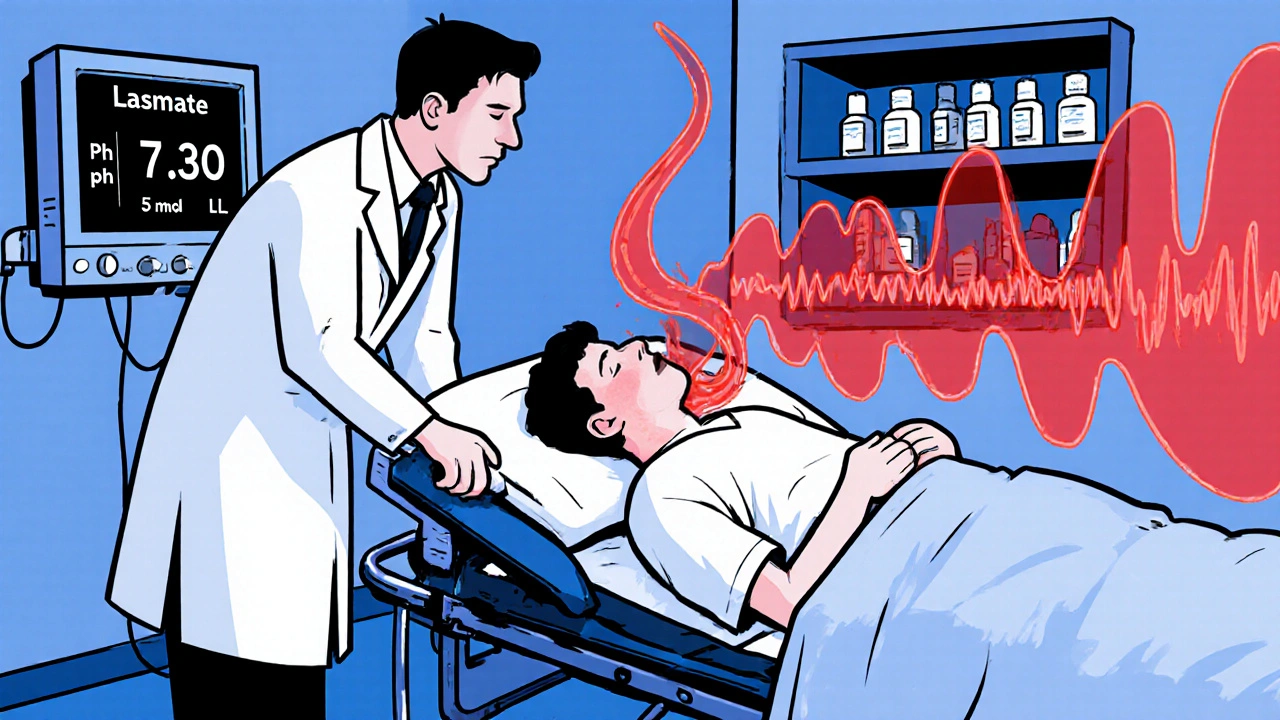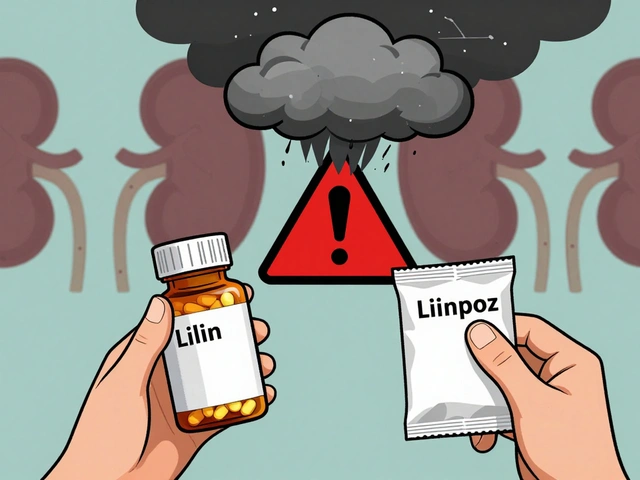Medication-Induced Lactic Acidosis Risk Calculator
When a drug pushes lactate levels past the safety line, the result can be a rapid, life‑threatening crash. Medication‑induced lactic acidosis is rare, but when it strikes, every minute counts. This guide walks you through what the condition is, which medicines are most often to blame, how to spot it early, and what to do once it’s identified.
What is medication‑induced lactic acidosis?
Lactic acidosis is a metabolic disturbance marked by a blood pH below 7.35, bicarbonate under 22 mmol/L, and lactate concentrations higher than 4-5 mmol/L (normal 0.5-2.2 mmol/L). When the cause is a drug rather than tissue hypoxia, clinicians label it type B lactic acidosis. The drug either interferes with mitochondrial energy production, boosts glycolysis, or hampers lactate clearance, letting lactate build up unchecked.
How often does it happen?
A systematic review in Pharmacotherapy (2019) screened 1,918 papers and found 286 documented cases linked to 59 different agents. Although the absolute number is low, mortality sits around 16 % overall and climbs to 66 % for certain drugs like propofol. The rarity often leads to under‑recognition, which in turn inflates the fatality rate.
High‑risk medications and how they cause the problem
Below is a snapshot of the most frequently cited culprits, the biochemical pathway they hit, and the rough incidence reported in the literature.
| Drug | Mechanism | Incidence (per 100,000 pts‑yr) | Mortality % |
|---|---|---|---|
| Metformin | Inhibits hepatic gluconeogenesis & raises anaerobic glycolysis when renal clearance falls | 3-10 | 22.2 |
| Linezolid | Blocks mitochondrial ribosomes, cutting aerobic ATP production | 2.5-15 (after >14 days) | ~12.5 |
| Albuterol (β2‑agonist) | Stimulates glycolysis and lipolysis, inhibiting pyruvate dehydrogenase | ≈30 (high‑dose nebulization) | 12.5 |
| Propofol (infusion syndrome) | Impaired fatty‑acid oxidation & mitochondrial dysfunction | 0.7-6.5 (high‑dose >48 h) | 66.7 |
| Epinenphrine | Massive β‑adrenergic stimulation drives glycolysis | ≈33 (ICU vasopressor use) | 12.5 |
| Nucleoside reverse transcriptase inhibitors (NRTIs) | Inhibit DNA polymerase‑γ → mitochondrial DNA depletion | 2-4 (HIV patients) | Varies |
| Acetaminophen (high‑dose, elderly) | Toxic metabolites disrupt mitochondrial oxidative phosphorylation | Rare, but under‑reported | Low |
| Phenformin (withdrawn) | Similar to metformin but far higher risk of lactate buildup | 40-64 (historical) | ≈50 |
Note that most cases involve a secondary stressor - sepsis, renal insufficiency, or prolonged infusion - that tips the balance toward acidosis.
Spotting the red flag: clinical presentation and diagnosis
Patients rarely present with “lactic acidosis” as a complaint. Instead, they develop a rapid, deep breathing pattern (Kussmaul respirations), nausea, vague abdominal pain, or unexplained tachycardia. The lab hallmark is a lactate >4 mmol/L together with a pH <7.35. Some experts argue for a lower lactate threshold (3 mmol/L) when a high‑risk drug is on board, because waiting can allow the acidemia to worsen.
A typical work‑up includes:
- Arterial blood gas for pH and bicarbonate.
- Serum lactate measurement (stat).
- Renal and liver function tests to gauge clearance capacity.
- Medication review - check doses, duration, and renal dosing adjustments.
- Screen for concurrent hypoxia, shock, or sepsis that could be the primary driver.
Serial lactate checks every 2-4 hours help confirm whether the trend is improving after interventions.

Immediate management steps
The first move is to stop the offending drug, unless it’s lifesaving (e.g., epinephrine during anaphylaxis). Then focus on reversing the metabolic derangement:
- Fluid resuscitation: 20-30 mL/kg crystalloid bolus to improve perfusion.
- Vasopressors: Only if hypotension persists after fluids.
- Hemodialysis: Strongly considered for metformin‑related cases with lactate >20 mmol/L or pH <7.1, as it clears both drug and lactate.
- Bicarbonate: Controversial; generally reserved for pH <7.15 when acidemia is causing arrhythmias.
- Address underlying triggers: Treat sepsis, correct hypoxia, adjust renal dosing.
Clinical experience shows lactate levels typically drop by about 50 % within the first two hours if the offending agent is withdrawn and perfusion is restored.
Prevention: risk stratification and monitoring
Because the condition is preventable in many cases, clinicians should adopt a checklist before starting or continuing a high‑risk drug:
- Assess renal function - eGFR <30 mL/min for metformin, <60 mL/min for NRTIs.
- Review comorbidities - liver disease, heart failure, or active infection raise the stakes.
- Choose the lowest effective dose and limit duration (e.g., linezolid <14 days).
- Implement routine lactate monitoring for patients on continuous epinephrine, propofol infusions, or high‑dose β‑agonists.
- Educate patients and families about early warning signs - rapid breathing, unexplained fatigue, or abdominal discomfort.
Newer technologies, such as the FDA‑approved continuous lactate monitor (Lactate Scout+), can alert the care team within minutes, cutting detection time from over 12 hours to around 2 hours in high‑risk settings.
Real‑world case snapshots
Albuterol - a bronchodilator commonly used for asthma - can backfire. In a 2025 HCA Healthcare report, a patient on standard albuterol nebulizations for COPD spiked to lactate 11 mmol/L. Reducing the nebulization frequency brought the value down to 4.5 mmol/L within six hours. This illustrates how a routine rescue inhaler can become a hidden danger in patients with limited hepatic clearance.
Metformin‑associated cases often need a second insult. A 70‑year‑old with moderate chronic kidney disease and a urinary tract infection developed a lactate of 9 mmol/L. Immediate cessation of metformin, aggressive IV fluids, and a single hemodialysis session normalized the lactate in 24 hours, and the patient survived.
For Propofol, prolonged high‑dose sedation in a burn ICU patient led to a classic propofol infusion syndrome: lactate 13 mmol/L, metabolic acidosis, and cardiac failure. Rapid discontinuation of propofol, switch to a non‑lipid sedative, and supportive ventilation halted the cascade, but the mortality risk in such scenarios remains above 60 %.

Looking ahead: research and guidelines
The 2024 International Critical Care Guidelines now specifically call for “routine lactate monitoring in any patient receiving continuous epinephrine or high‑dose β‑agonist therapy.” Ongoing studies aim to validate genetic markers (e.g., POLG variants) that may predict susceptibility to NRTI‑related lactic acidosis. Meanwhile, hospitals are piloting lactate‑clearance protocols that tie medication review to every lactate spike above 3 mmol/L, a practice that early data suggest cuts severe cases by about a quarter.
Quick checklist for clinicians
- Know the high‑risk drugs: metformin, linezolid, albuterol, propofol, epinephrine, NRTIs, acetaminophen (elderly), phenformin (historical).
- Screen for renal/hepatic impairment before prescribing.
- Set lactate monitoring thresholds: >4 mmol/L (or >3 mmol/L if on a high‑risk drug).
- Stop the suspect medication promptly unless absolutely essential.
- Provide fluids, consider dialysis for metformin, and address the underlying cause.
- Re‑measure lactate every 2-4 hours until it falls below 2 mmol/L and pH normalizes.
Bottom line
Medication‑induced lactic acidosis is a rare, high‑mortality event that hides behind common drugs and critical‑illness scenarios. Early recognition hinges on a low threshold for checking lactate in at‑risk patients, a quick drug‑stop decision, and aggressive supportive care. With modern monitoring tools and a disciplined risk‑assessment checklist, clinicians can turn a potentially fatal surprise into a preventable complication.
What lactate level defines medication‑induced lactic acidosis?
A serum lactate above 4 mmol/L together with a pH below 7.35 and bicarbonate under 22 mmol/L meets the classic definition. Some clinicians use a lower lactate cut‑off (3 mmol/L) when a high‑risk drug is being administered.
Which patients are most vulnerable?
Elderly individuals, those with renal impairment (eGFR < 60 mL/min), liver disease, sepsis, or any condition that reduces lactate clearance are at highest risk, especially when taking metformin, NRTIs, or high‑dose β‑agonists.
Should I always stop the offending drug?
In most cases, yes. The exception is when the drug is the only life‑saving therapy (e.g., epinephrine in anaphylaxis). Then you weigh the benefit against the severity of acidosis and consider dose reduction or adjunctive measures.
Is bicarbonate therapy useful?
Guidelines advise against routine bicarbonate because it doesn’t improve mortality and may cause sodium overload. It’s reserved for severe acidemia (pH < 7.15) when cardiac instability is evident.
How does hemodialysis help with metformin‑related cases?
Hemodialysis clears both metformin and lactate efficiently, especially when lactate exceeds 20 mmol/L or pH drops below 7.1. Early dialysis can cut the mortality from roughly 22 % to under 10 % in severe MALA.





Diane Holding
If you suspect medication‑induced lactic acidosis, stop the offending drug immediately, start aggressive bicarbonate therapy, and monitor lactate trends closely.
Cheyanne Moxley
People need to get their heads out of the clouds and realize you can't just dump metformin on a failing kidney and not expect trouble.
Kevin Stratton
When we contemplate the very nature of iatrogenic metabolic derailment, we find ourselves staring into the abyss of biochemical determinism, a reminder that every pharmacologic choice ripples through the mitochondrial matrix like a stone in a still pond :)
Manish Verma
Look, our healthcare system shouldn't be a free‑for‑all drug buffet for anyone with a prescription pad. When clinicians swing the line of metformin, linezolid, or propofol without regard for renal function or infusion duration, they're basically inviting the nation’s most vulnerable into a lethal dance. It’s high time we tighten the rules, educate the front‑liners, and stop glorifying risky protocols as ‘standard care.’
Megan Dicochea
Medication induced lactate spikes are often hidden behind a storm of other critical illness signs the patient is already fighting the labs can be misleading especially when you have a background of renal impairment the key is vigilance and early drug discontinuation also consider alternative agents when possible especially in the ICU setting where the risk accumulates quickly